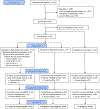Cancer survivorship care for young adults: a risk-stratified, multicenter randomized controlled trial to improve symptoms
- PMID: 34590205
- PMCID: PMC9438455
- DOI: 10.1007/s11764-021-01105-8
Cancer survivorship care for young adults: a risk-stratified, multicenter randomized controlled trial to improve symptoms
Abstract
Purpose: Young adult (YA) cancer survivors have high rates of adverse health and psychosocial outcomes. This risk-stratified, multicenter, randomized controlled trial (RCT) compared a self-management survivorship intervention to usual care in YA survivors with symptoms of cancer-related distress, insomnia, fatigue, pain, and/or depression.
Methods: Eligibility included age 18-39 at diagnosis with an invasive malignancy in the previous 1-5 years. Baseline assessment determined "high need" participants, with 2-5 elevated targeted symptoms. We randomized high need participants to intervention or usual care and offered intervention participants a survivorship clinic visit, which included mutually decided action plans for symptoms. Follow-up calls at 1 and 3 months after the clinic visit reviewed action plan progress. Outcomes compared rates of improved symptoms for intervention vs usual care at 6 months and 12 months.
Results: N = 344 completed baseline assessment, with n = 147 (43%) categorized as high need and randomized. Of n = 73 randomized to the intervention, n = 42 (58%) did not attend their survivorship clinic visit. In intent-to-treat analyses, aggregate symptom scores did not differ between arms, though distress improved for 46% in the intervention arm at 6 months compared to 18% in usual care (p = 0.03) among those with elevated distress at baseline.
Conclusions: Distress improved for YAs who received self-management survivorship care. However, the study demonstrates a need for alternative strategies for providing YA survivorship care.
Trial registration: NCT02192333 IMPLICATIONS FOR CANCER SURVIVORS: While YA survivors demonstrate some improved distress when provided survivorship care, to make care accessible and effective, they require options such as remote delivery of care.
Keywords: AYA; Cancer survivor; Randomized controlled trial; Risk-stratified; Survivorship care plan; Young adult.
© 2021. The Author(s), under exclusive licence to Springer Science+Business Media, LLC, part of Springer Nature.
Conflict of interest statement
References
-
- Howlader N, Noone AM, Krapcho M, Garshell J, Miller D, Altekruse SF et al. SEER cancer statistics review, 1975–2012, National Cancer Institute. Bethesda, MD, http://seer.cancer.gov/csr/1975_2012/. Accessed April 15, 2021.


